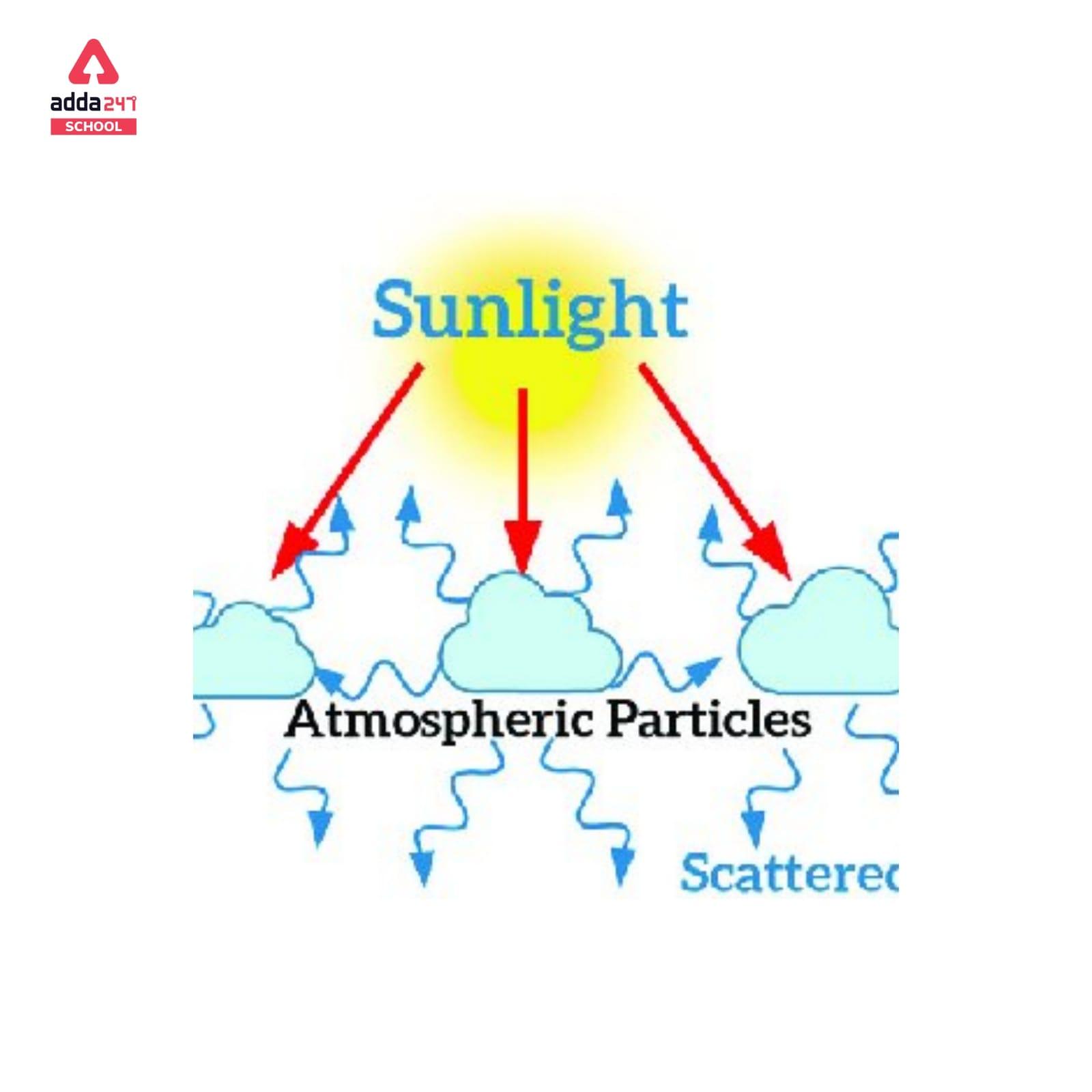Table of Contents
Scattering of light
Scattering of Light is a physics term that refers to a variety of physical processes in which moving particles or radiation of some kind, such as light or sound, are forced to deviate from a straight path due to localized non-uniformities (including particles and radiation) in the medium through which they pass. Scattering of light also includes the departure of reflected radiation from the angle anticipated by the law of reflection in traditional usage.
What is Scattering of light Meaning?
Scattering of light Meaning is Particle-particle collisions between molecules, atoms, electrons, photons, and other particles are referred to as scattering. Cosmic ray scattering in the high atmosphere, particle collisions inside particle accelerators, electron scattering by gas atoms in fluorescent lamps, and neutron scattering inside nuclear reactors are just a few scattering of light examples.
Read More:
- Area Of Sphere- Formula In Maths
- BODMAS Full Form With Sign, Examples In Computer
- Rank Of The Matrix – Definition, Formulas, Examples
- SSC Full Form- What Is Staff Selection Commission?
Scattering of light Definition
Scattering of light is defined as The source of light that may be explored completely. When light moves from one medium to another, such as air or a glass of water, a portion of the light is absorbed by the medium’s particles, followed by subsequent radiation in a specific direction. The scattering of light is the term for this phenomenon. The size of the particles and the wavelength of the light affect the intensity of scattered light.
Because of the waviness of the line and its interaction with a particle, shorter wavelengths, and high frequencies scatter more. The more wavy a line is, the more likely it is to intersect with a particle. Longer wavelengths, on the other hand, have a lower frequency and are straighter, therefore the chances of colliding with a particle are lower.
Who Discovered Scattering of light
Due to refraction and entire internal reflection of light, the bending of multicoloured light can be seen in the afternoon. In different directions, the wavelength of sunlight produces distinct colours. The red colour of the sun in the morning and the blue colour of the sky are explained by Rayleigh scattering theory.
If p is the probability of scattering and λ is the wavelength of light, the equation becomes:
| P ∝ 1/λ4 |
For shorter wavelengths, the chance of scattering of light increases rapidly, and it is inversely proportional to the fourth power of the wavelength of light.
Scattering of light Examples
To date, light scattering has been used in a wide range of applications. The following is a list of them:
- The light scattered by the particles in the atmosphere causes the sky to seem blue.
- The sky appears crimson during sunset and sunrise due to light scattering.
- In terms of projectors
- In the medical field.
- It gives a quick overview of physical uniformities’ size, shape, quantity, and temporal independence.
- It’s utilised to figure out what’s going on with crucial phenomena.
- It aids in the determination of molecular weight.
- It is crucial in the analysis of air pollution.
- It explains the phenomenon of dissemination.
Scattering of light Reflection
When a ray of light strikes a polished, smooth, or glossy item, the light from that object reflects back to our eyes, which is known as “Reflection” or “Reflection of Light.”
This phenomenon is what allows us to see the world via our eyes. Light travels in a straight line before, after, and during reflection. For instance, the flashing of stars or the reflection of light in a mirror.
Examples of Scattering of light by Prism- Refraction
The bending of light (as well as sound, water, and other waves) when it flows through one transparent substance into another is known as refraction. This phenomenon is most commonly observed when the light is passed through a prism. A prism not only scatters the light by refraction, but also it separates the different coloured lights having different wavelengths.
Lenses, magnifying glasses, prisms, and rainbows are all conceivable because of this bending through refraction. Even our eyes are reliant on light bending. We wouldn’t be able to concentrate light onto our retina without refraction.
Read More Articles:
- Highest Dam In India
- Which Is The Longest Dam In India?
- How Many States And Capitals Of India
- Aufbau Principle Definition, Formula, Example, Limitation
Scattering of Light can be seen in
Scattering of light refers to the phenomenon where light is redirected in different directions as it passes through a medium containing particles or irregularities. This scattering of light effect is responsible for various natural phenomena and is commonly observed in the following situations:
- Rayleigh Scattering: This type of scattering of light occurs when light interacts with particles or molecules that are much smaller than the wavelength of the light. Rayleigh scattering is responsible for the blue color of the sky during the day. The shorter blue wavelengths of sunlight are scattered more efficiently by the molecules in the Earth’s atmosphere, causing the sky to appear blue to an observer on the ground.
- Tyndall Effect: The Tyndall effect is observed when light passes through a colloidal solution or a suspension of very fine particles. The light is scattered by these particles, making the path of the light visible. This effect can be seen in phenomena such as the scattering of sunlight by dust or smoke in the air, making the light beams visible in a dark room.
- Mie Scattering: Unlike Rayleigh scattering, Mie scattering occurs when light interacts with particles that are similar in size to the wavelength of the light. Mie scattering is responsible for phenomena like the white appearance of clouds, where water droplets scatter sunlight in various directions, resulting in a diffuse white color.
- Scattering in Gemstones: Certain gemstones, such as opals, exhibit scattering phenomena due to the presence of small particles and voids within their structure. This scattering effect creates unique patterns of colors, known as “play-of-color,” giving opals their characteristic iridescence.
- Scattering in Water Bodies: Light scattering also occurs in large bodies of water, such as lakes and oceans. Suspended particles, plankton, and other organic matter in water can scatter sunlight, affecting the color and visibility of the water.
- Scattering in Astronomy: Scattering of starlight by interstellar dust and gas can cause celestial objects to appear redder or dimmer, known as interstellar reddening and extinction, respectively.
Overall, the scattering of light is a common and fascinating optical phenomenon that plays a crucial role in our daily experiences and helps explain various natural phenomena we observe in the world around us.
Scattering of Light QNAs
What is meant by scattering of light?
The term “scattering of light” refers to the act of directing light in various random directions. When light strikes various sorts of suspended particles in its path, it scatters.
Consider the following scenario: When sunlight enters the earth’s atmosphere, it is absorbed by the atoms and molecules of various gases present in the air. The light is then re-emitted in all directions by these atoms. Scattering of light is the name for this process.
What causes light to scatter?
When light passes through a medium, it interacts with the medium, resulting in light scattering. Photons are absorbed by molecules in the medium, causing them to vibrate and re-emit the photons.
What are scatteringtypes?
Rayleigh scattering, Mie scattering, and non-selective scattering are the three forms of scattering. Rayleigh scattering is primarily made up of atmospheric gas scattering. When the scattering particles are smaller than the wavelengths of radiation in contact with them, this happens.
Who discovered scattering of light?
Sir C. V. Raman found in 1928 that a fraction of the light scattered by a liquid was of a different colour when a beam of coloured light reached the liquid. The nature of this scattered light was shown by Raman to be depending on the sort of sample present.
What type of mixture is scatter light?
A colloid is hazy and uniform in appearance, and the particles do not settle out like they do in a suspension. Light scattering reflects light, allowing the beam of light to be seen.
What is the difference between scattering of light and dispersion of light?
Scattering occurs when a light ray deviates from its initial path and travels in a new direction. When a light ray collides with a particle or a surface, it scatters. The splitting of white light into its constituent hues is known as dispersion.
Do suspensions scatter light?
Unlike colloid particles, particles in a suspension can be separated by filtering. Light can be scattered by colloids, but it cannot be transmitted by suspensions. Particles in a suspension can be seen with the naked eye, whereas colloid particles require the use of a light microscope.


 SOF Olympiad Exam Date 2024-25 Out, Chec...
SOF Olympiad Exam Date 2024-25 Out, Chec...
 NEET Revised Answer Key 2024 Out, Downlo...
NEET Revised Answer Key 2024 Out, Downlo...
 Karnataka PGCET Admit Card 2024 Out, Dow...
Karnataka PGCET Admit Card 2024 Out, Dow...












